What is a Solar System for a Camper?
A solar system is a set of equipment designed to utilize solar energy in a camper. Typically, it includes panels that convert sunlight into electricity, batteries for storing energy, controllers to manage charging, and inverters to convert energy into the required form. Solar systems on campers provide travelers with independence from external power sources, allowing them to charge devices, light spaces, and even run household appliances.
1. Types of Solar Panels for Campers
Solar panels are the main component of the system that converts solar radiation into electrical energy. Today, there are several types of solar panels, each with its own advantages and disadvantages that are important to consider when choosing.
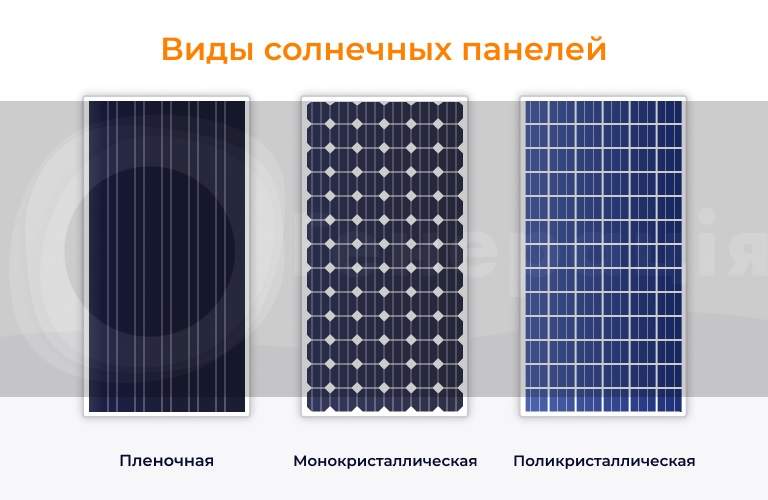
Monocrystalline Panels
Monocrystalline panels are made from a single silicon crystal, which provides high efficiency. They are the most popular for camper installations because they are compact and can generate more energy per smaller area.
Advantages:
- High efficiency (up to 22% under ideal conditions)
- Durability (lifespan up to 25 years)
- Compact size and aesthetics (take up less space)
Disadvantages:
- High cost
- Loss of efficiency in low light (cloudy days or morning/evening)
Monocrystalline panels are best suited for limited spaces, such as a camper roof, where maximizing power per square meter is important.
Polycrystalline Panels
Polycrystalline panels are made from multiple silicon crystals and are more affordable but less efficient.
Advantages:
- Affordable price (about 20-30% cheaper than monocrystalline)
- Good efficiency under normal sunlight conditions
Disadvantages:
- Lower efficiency (around 15-18%)
- Larger size for the same power (important if space is limited)
Polycrystalline panels are a good choice for those seeking a balance between price and quality.
Thin-Film Panels
Thin-film panels are made from various materials like amorphous silicon or selenium. They are lighter and more flexible but have the lowest efficiency.
Advantages:
- Lightweight and flexible (can be used on different surfaces)
- Low price
Disadvantages:
- Low efficiency (about 10-12%)
- Larger size for the same power
- Shorter lifespan
Thin-film panels are less commonly installed on campers but their flexibility makes them interesting for non-standard solutions.
2. Types of Batteries for Camper Solar Systems
The battery is a crucial component that stores energy collected from solar panels and powers electrical devices. It’s important to choose a battery that is reliable, durable, and suitable for camper conditions.
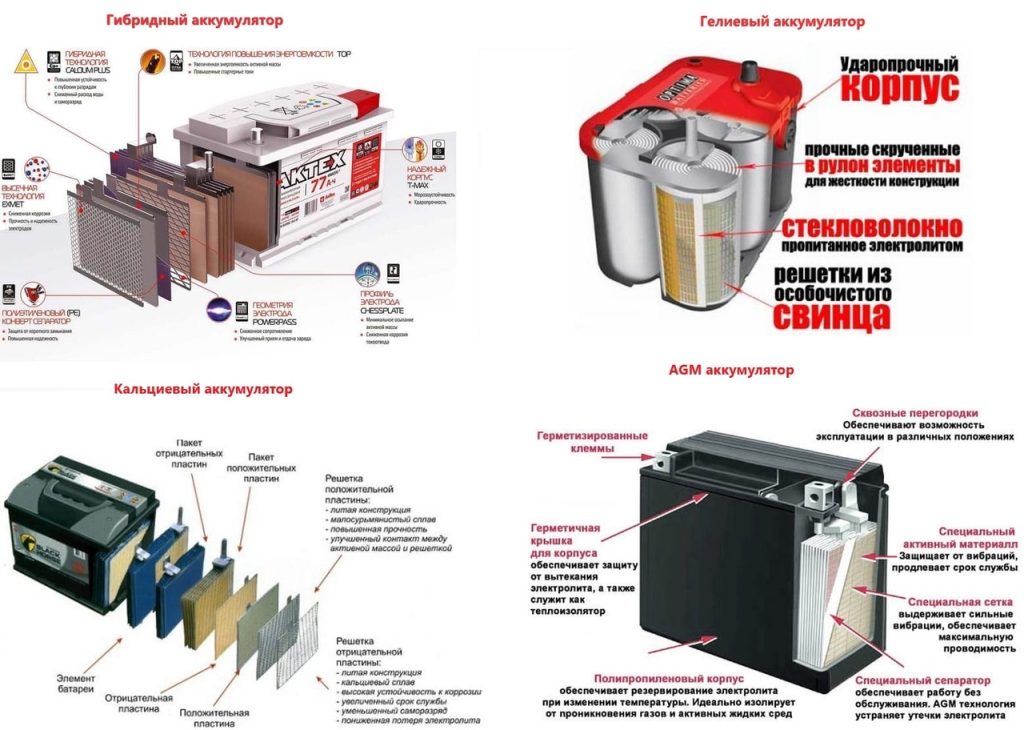
Lead-Acid Batteries
Lead-acid batteries are a standard choice for budget solar systems. They are widely available and inexpensive but have limitations.
Advantages:
- Affordable price
- Widely available (can be found in any auto parts store)
Disadvantages:
- Short lifespan (about 3-5 years)
- Lower capacity and heavier than lithium-ion batteries
- Require regular maintenance (adding water, charge level checks)
Lithium-Ion Batteries
Lithium-ion batteries are increasingly popular due to their high capacity, durability, and light weight.
Advantages:
- Long lifespan (up to 10 years or more)
- Low weight and compact size
- Higher efficiency (less energy loss during charging/discharging)
Disadvantages:
- High cost (though prices are decreasing with technology improvements)
- Require special charging equipment and overheating protection
Gel Batteries
Gel batteries are an advanced type of lead-acid battery that uses a gel electrolyte instead of liquid. They are more resistant to damage and overloads.
Advantages:
- Long lifespan (up to 7 years)
- Resistant to deep discharges and damage
Disadvantages:
- High cost
- Require regular maintenance
Gel batteries are ideal for campers as they are less prone to leaks and can endure loads for a long time.
3. Charge Controllers: Managing Energy
Charge controllers regulate the charging process from solar panels to batteries. They prevent overcharging and protect batteries from damage. There are two types of charge controllers: PWM and MPPT.
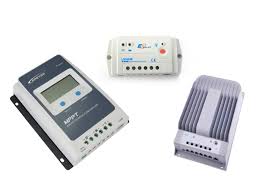
PWM Controllers
PWM (Pulse Width Modulation) controllers are simpler devices that reduce the voltage to the battery as it charges. They are cheaper and easier to install.
Advantages:
- Affordable price
- Easy installation and use
Disadvantages:
- Lower efficiency (up to 30% losses compared to MPPT)
- Fewer adjustment options
MPPT Controllers
MPPT (Maximum Power Point Tracking) controllers are much more efficient because they track the optimal power point of the solar panels and extract maximum energy.
Advantages:
- High efficiency (up to 30% more energy than PWM)
- Better for high-power panels
Disadvantages:
- Higher cost
- More complex installation and setup
4. Types of Inverters
An inverter converts the direct current (DC) generated by solar panels and batteries into alternating current (AC), used by most appliances.

Pure Sine Wave Inverters
Pure sine wave inverters produce a clean sine wave, making them ideal for sensitive devices.
Advantages:
- High stability
- Suitable for all types of appliances
Disadvantages:
- High cost
Modified Sine Wave Inverters
Modified sine wave inverters can be used for most household appliances but are not recommended for delicate electronics.
Advantages:
- Affordable price
Disadvantages:
- Lower stability for sensitive devices
5. Wiring and Important Considerations
When connecting solar panels and batteries, it’s important to consider correct wire gauge and length to avoid energy losses. Wires should be thick enough to minimize resistance losses.
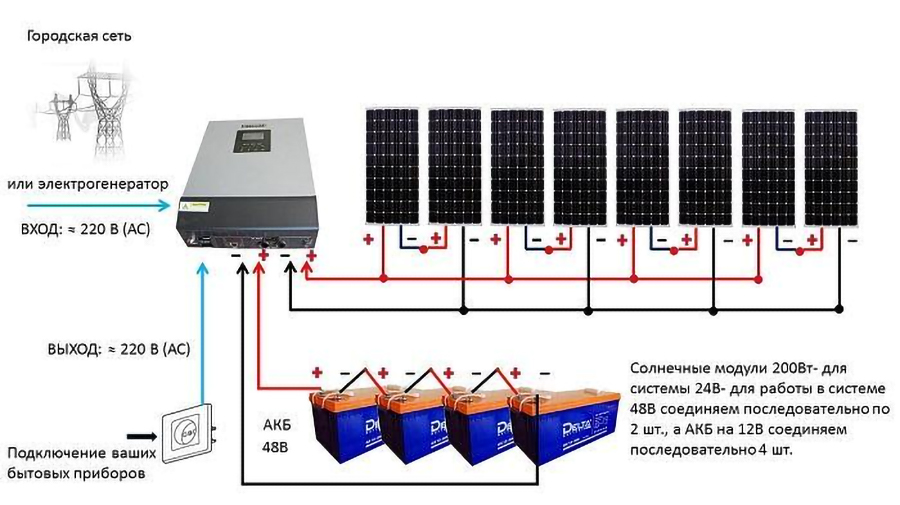
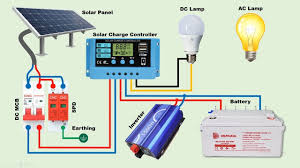
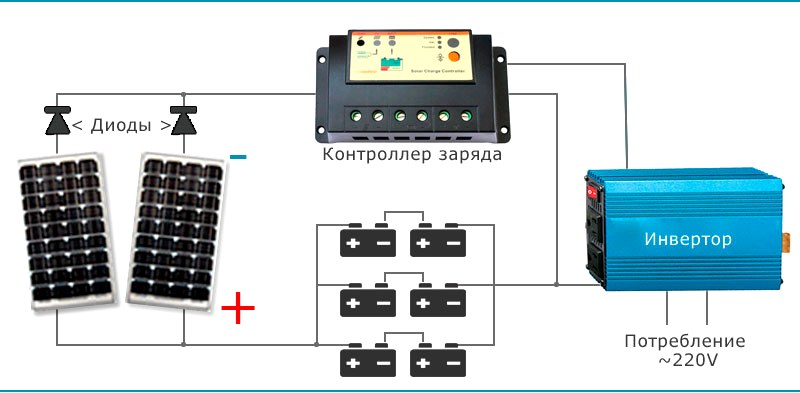
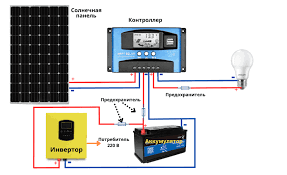
Wiring Gauge
For camper solar panels, cables with a cross-section of 4 to 6 mm² are recommended for short distances. For longer distances (e.g., if panels are far from the controller), cable thickness should be increased to 10 mm² to reduce losses.
Series and Parallel Connections
Panels can be connected in series or parallel. Series connection increases voltage, parallel increases current. It’s important to match the inverter and controller specs to choose the right connection.
Risks:
- System overload — improper connection can cause overheating
- Need for grounding — lack of grounding can lead to short circuits or equipment damage
Controller Installation Location
Charge controllers should not be installed near batteries to avoid overheating and efficiency loss. It’s best to place them in a cool, dry place protected from direct sunlight.
How to Calculate the Power of a Solar System for a Camper?
Proper power calculation is a key part of planning a solar panel installation on a camper. To determine what equipment you need, consider the power consumption of your devices and their operating time, as well as the characteristics of panels, batteries, and inverters. The system should be balanced and efficiently supply energy throughout your trip.
1. Power Calculation of the Solar System
First, estimate how much energy you’ll need to power all devices you plan to use. Typical household devices and their power consumption:
- Air grill: about 1500 W (1.5 kW)
- Multicooker: about 800 W
- Vacuum cleaner: about 1000 W
- Hair dryer: about 2000 W
If you plan to use these devices simultaneously, total power is about 5300 W. However, these devices run only for short periods, e.g., air grill for 30 minutes, hair dryer for 20 minutes.
Example:
Using the air grill for 30 minutes:
Energy consumption = 1500 W * 0.5 h = 750 Wh (0.75 kWh)
If during the day you also use the hair dryer 20 minutes, vacuum cleaner 30 minutes, multicooker 1 hour, calculate similarly:
- Hair dryer: 2000 W * 0.33 h = 660 Wh
- Vacuum cleaner: 1000 W * 0.5 h = 500 Wh
- Multicooker: 800 W * 1 h = 800 Wh
Total daily energy consumption:
750 + 660 + 500 + 800 = 2710 Wh or 2.71 kWh
2. Choosing Solar Panels
Panels have different power ratings. For example, a standard 100 W panel generates about 400-500 Wh per day under good sunlight. Assume one 100 W panel produces 0.4 kWh daily.
To cover 2.71 kWh daily:
2.71 kWh / 0.4 kWh = 6.775 panels
Round up to 7 panels of 100 W each to provide enough energy.
3. Calculating Battery Capacity
To ensure power at night or on cloudy days, choose a battery capacity accordingly. It’s usually recommended to have a battery capacity to store energy for 1-2 days without recharging.
Battery capacity (Ah) = Energy consumption (Wh) / Battery voltage (V)
For 12 V battery system and 2.71 kWh energy:
2.71 kWh = 2710 Wh
2710 Wh / 12 V = 225.8 Ah
You’ll need a battery of at least 225 Ah. For longevity, it’s better to have some margin, for example two 100 Ah batteries combined.
4. Choosing an Inverter
The inverter converts DC from the battery to AC for appliances. For devices like air grill, hair dryer, vacuum cleaner, choose an inverter with power of at least 3000 W.
Select an inverter with a peak output power (for startup loads) 2-3 times the nominal power. For example, for devices with 2000 W peak, inverter should support about 3000 W or more.
5. Charge Controller
The charge controller regulates battery charging to prevent overcharging. With 7 panels of 100 W each, total 700 W.
Controller current rating should be 20-30% higher than max panel current.
For 700 W system at 12 V:
Current = 700 W / 12 V = ~58 A
Choose a controller rated for about 40-50 A (accounting for losses and safety).
Final Recommendations
For a solar system powering devices like air grill, hair dryer, vacuum cleaner, multicooker with daily consumption of 2.71 kWh, you need:
- 7 solar panels of 100 W each
- Battery capacity about 225 Ah (or two 100 Ah batteries)
- Inverter of 3000 W (peak power 6000 W)
- Charge controller rated for 40-50 A
This system can power various household devices in a camper, providing autonomy and comfort for long trips.
6. The Future of Solar Technology: What to Expect in 5 Years?
Solar technology has improved significantly in recent years. Panel efficiency is increasing, and costs are decreasing. In the future, expect better batteries (higher capacity, smaller size), as well as more efficient controllers and inverters.
Manufacturers are working on new panel types that work better in low-light conditions and flexible panels that can be installed on any surface.
